Named after one of Scotland’s most enigmatic folk heroes, The Rob Roy Way hiking trail connects the town of Drymen, north of Glasgow, to Pitlochry, on the southern edge of the Cairngorms, through some of the Highlands’ more accessible, yet overlooked, territory. But in what way does the trail connect to its eponymous figurehead?
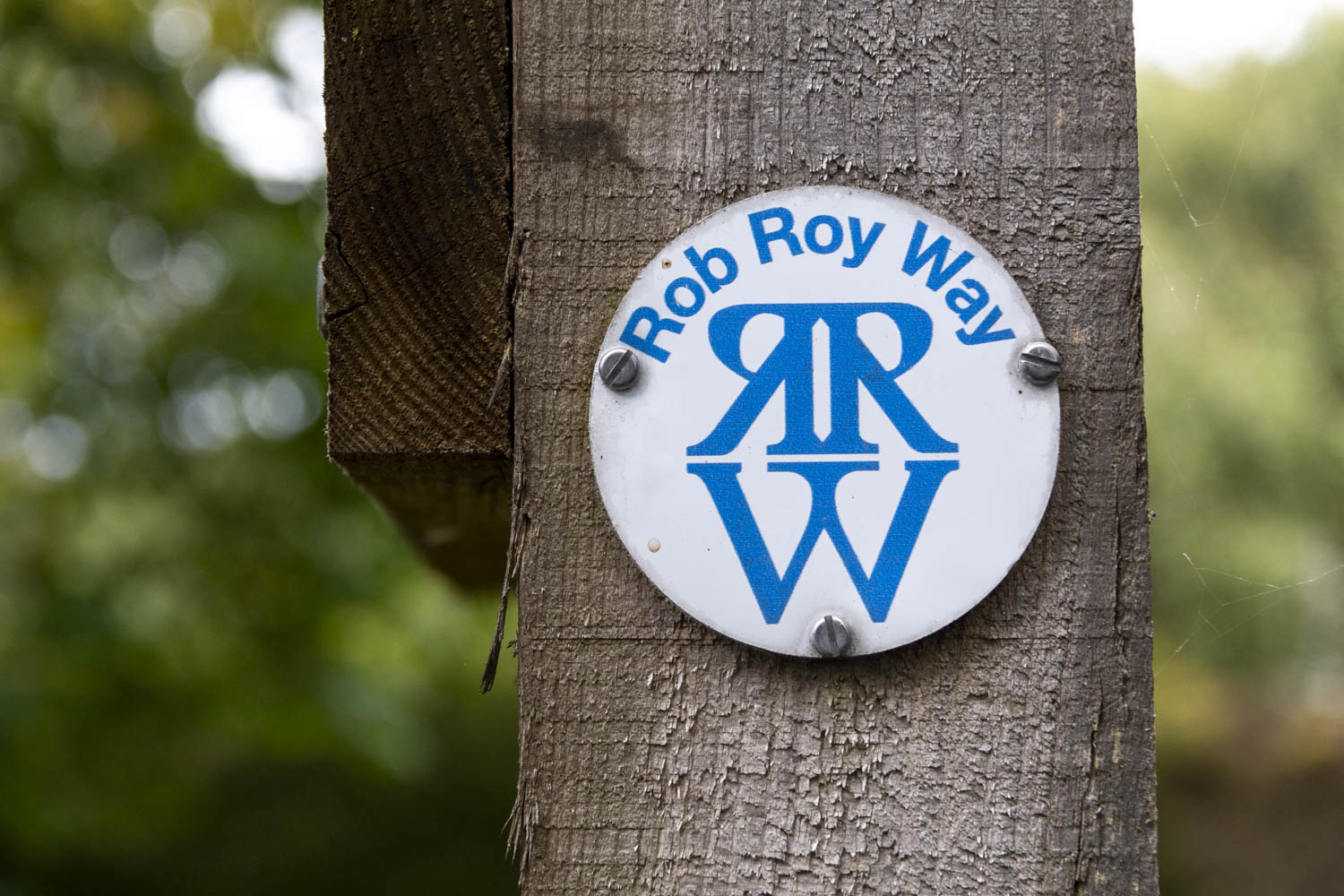
Official Rob Roy Way marker (Photo: Paul Stafford for TravelMag.com)
Rob Roy MacGregor. It is a name that conjures up images of heroism, chivalry and generosity; of a hirsute warrior in a kilt and sporran standing atop a cliff, his shaggy hair tousled by the wind. He’s the type with the brains to match his brawn, which is why he evades capture from the Crown’s soldiers.
This is the Walter Scottification of the Highland rebel, at least. His legacy was irreversibly shaped by Scott’s 1817 novel and the popular culture that has followed, including the 1995 movie starring Liam Neeson as Rob Roy. This has gradually forced history, through gentle reconfigurations, to become folklore.
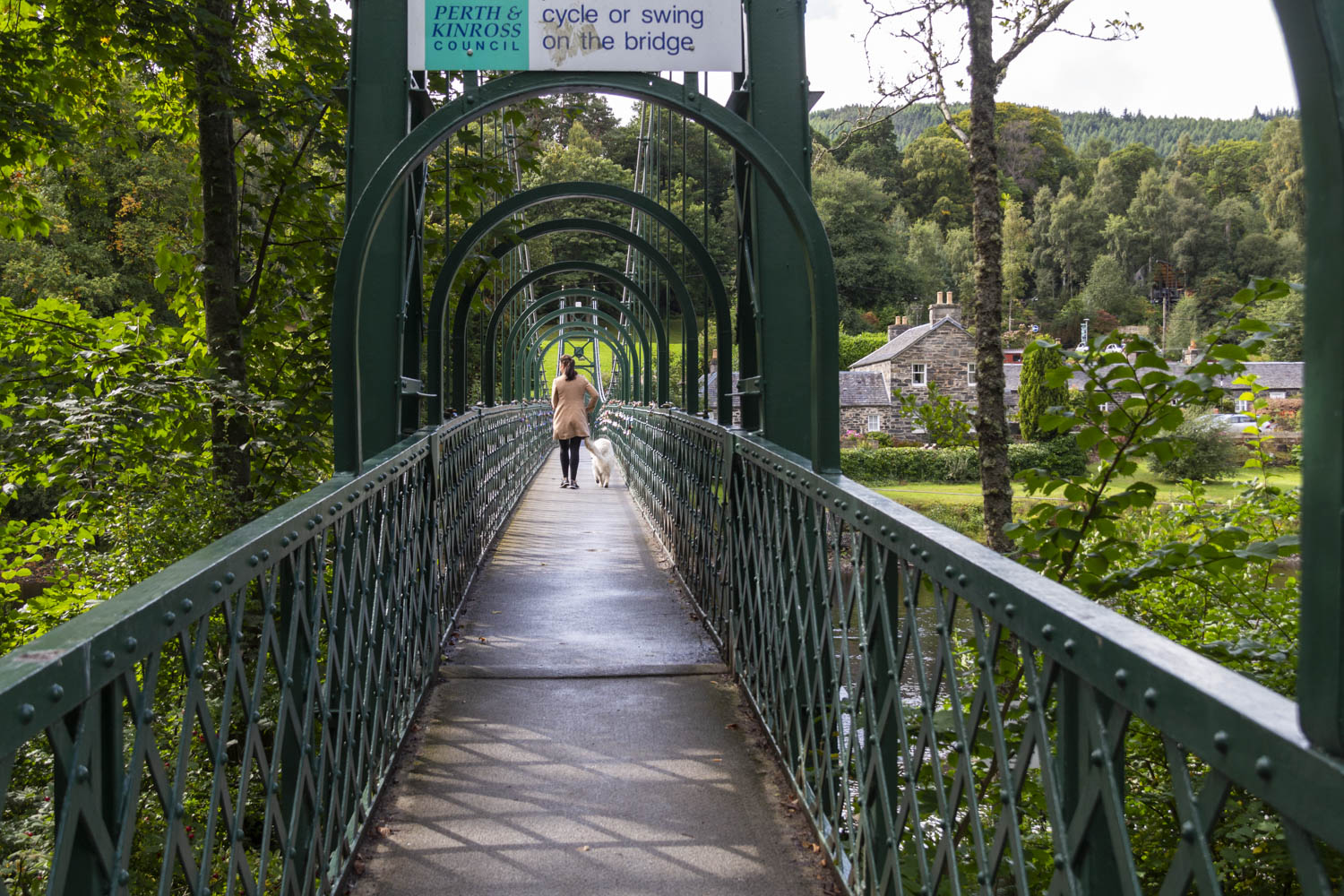
Iron bridge at Pitlochry (Photo: Paul Stafford for TravelMag.com)
My only hope was that no such ambiguity surrounded the directions as I set out hiking the Rob Roy Way. But I also wanted to honour him too. So when the official website suggested I hike the 77-mile (124-km) route in seven days, starting in Drymen and finishing in Pitlochry, I laughed. Following official rules did not seem very “Rob Roy,” so I planned to do it in three days from Pitlochry to Drymen instead. Only in hindsight did it seem foolish.
Near Misses
What should have been the tail end of the walk was therefore my trailhead. It was also the start of what seemed to be a series of near-misses on the part of the route’s planners. Places that can actually be linked to Rob Roy with any degree of certainty were not included. For example, a few miles north of the path to Pitlochry is Killiecrankie, where Rob Roy is believed to have tasted his first battle in 1689.
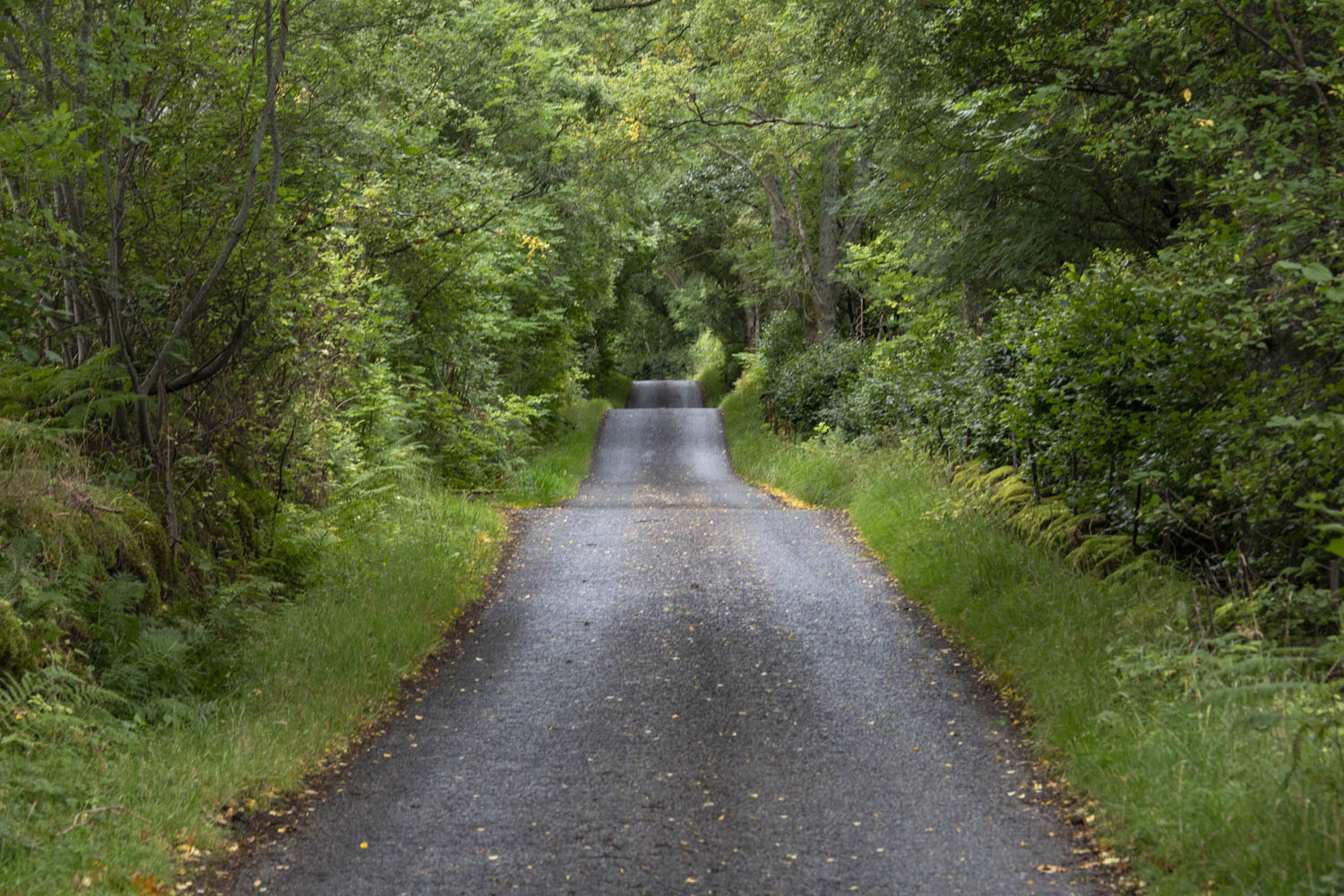
The Loch Tay south shore road beyond Ardtalnaig (Photo: Paul Stafford for TravelMag.com)
Not wanting to let unofficial detours add to the distance before I had even started, I set out, crossing a sturdy green iron suspension bridge and heading up the forested slope of Dunfallandy Hill. Gentle rays of sun threaded through canopy’s imperfections. On the other side of the hill, the forest gave way to windswept grassland offering an inviting view along the Tay Valley towards the peak of Ben Lawers.
Tame Lands
Wind ruffled the gorse. The gentle valley merely hinted at the desolate Scotland that could once conceal a fugitive for years, if not forever. To get closer to that rugged land, I first dropped down to the River Tay, through flowerbox villages, then walked along an elevated path beside the river, tracing the route of a former railway track, to Aberfeldy.
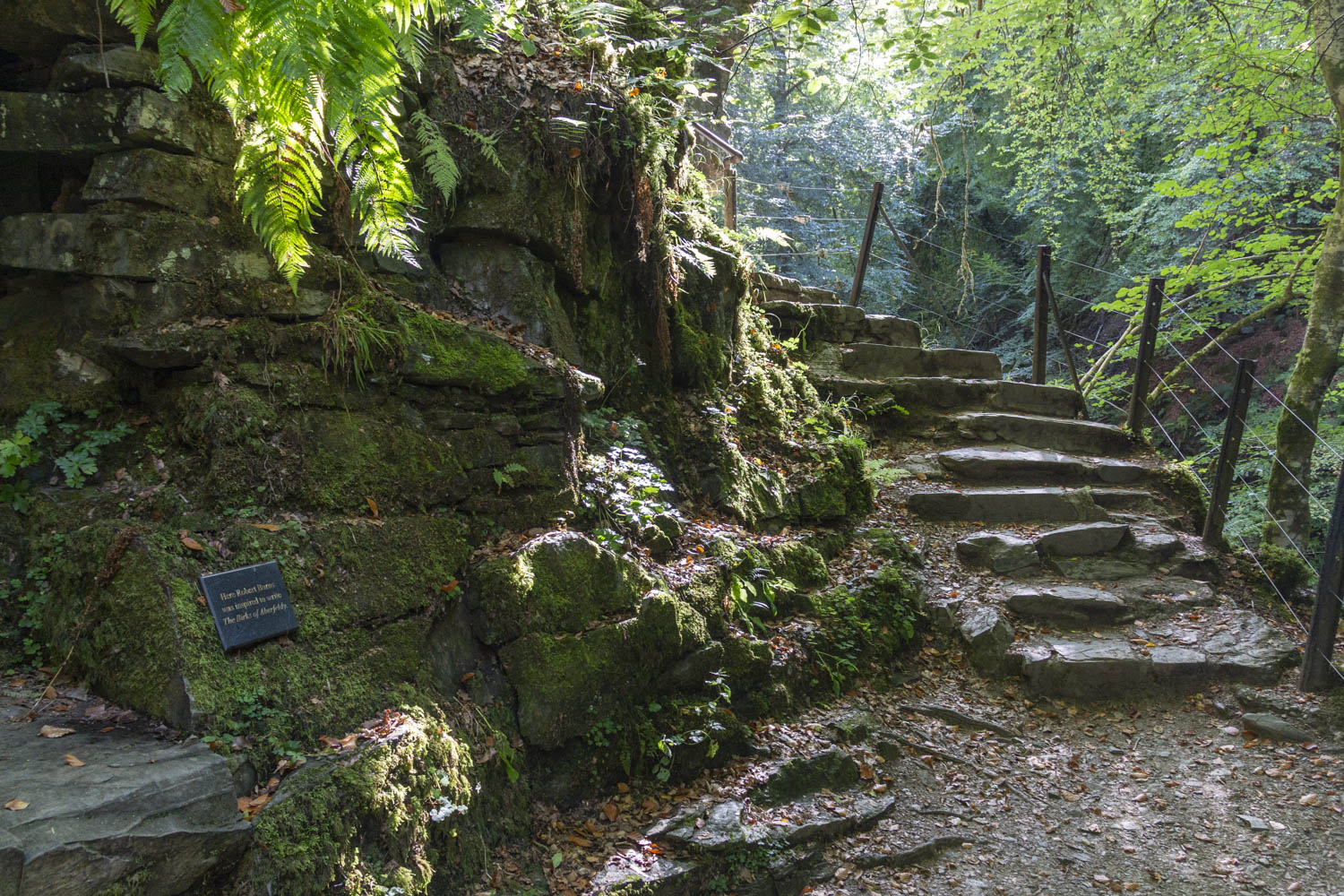
Path through the Birks of Aberfeldy (Photo: Paul Stafford for TravelMag.com)
From there, the path worked its way up past the Birks of Aberfeldy and into forestry plantations, then hair-pinned its way back down to the banks of Loch Tay, which glinted bright like an overexposed photo. Kenmore, at the head of the loch, seemed much too refined, too tame for an outlaw. Small boats and daysailers bobbed on the loch’s furrowed surface in front of uniform white cottages enveloped in thick green foliage that were beginning to suggest a turn of the seasons. It was starting to get late. I hurried along miles of quiet country road, that followed the loch’s southern shore while Ben Lawers dominated the view behind, to Ardtalnaig.
At the end of the first day of hiking, feet numb from the miles traversed, I realised two things: First, that there had been nothing, over the course of 25 miles, that seemed to have any obvious connection to Rob Roy. Second, and perhaps more importantly, that I was perhaps a tad ambitious in my planning. There was not much to be done about the latter issue, but as to the former, I could only assume the paths were likely those used by Rob Roy during his years as a cattle drover, which would have taken him all over the country. Walter Scott in Rob Roy described the drovers, somewhat unkindly, as: “Hordes of wild shaggy, dwarfish cattle and ponies, conducted by Highlanders, as wild, as shaggy, and sometimes as dwarfish, as the animals they had in charge.”
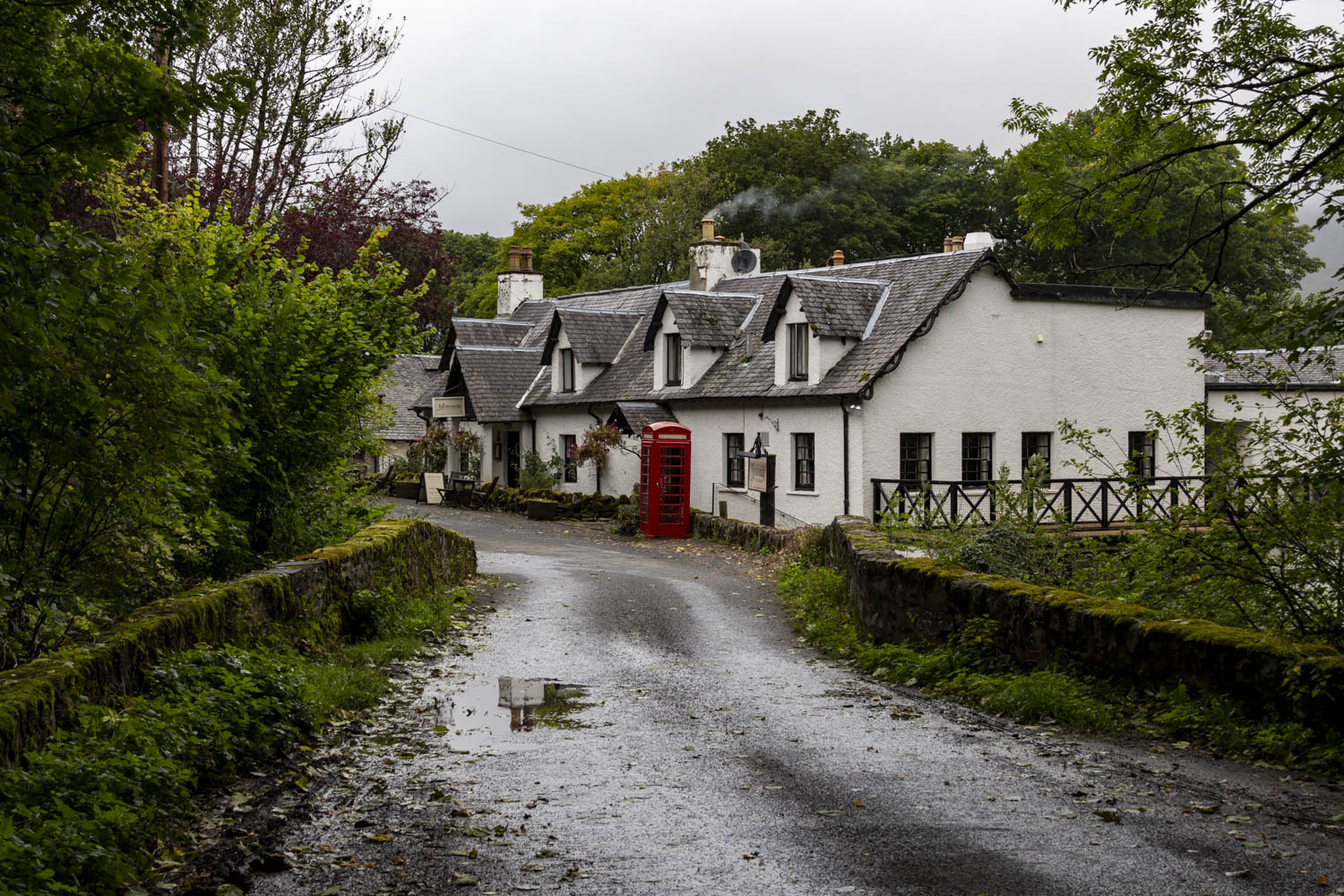
Buildings in Ardeonaig village (Photo: Paul Stafford for TravelMag.com)
Years before, it is believed that Rob Roy and his brothers ran the Lennox Watch. Cattle rustling, known as reiving, blighted the poorly policed Highlands in the late 17th– and early 18th-centuries (the reivers were known locally as herd widdiefows, or mad herdsmen). This gave rise to protection rackets, like the Lennox Watch, whereby payment was requested from landholders of estates to recover their stolen cattle. Often those running the rackets were the same ones doing the rustling. So it goes. The surplus animals were then amassed into herds of their own and used as payment or gifted to locals to inspire goodwill towards the protection rackets.
These parallels to the mafia are what make Rob Roy a divisive figure. W.H. Murray, in Rob Roy MacGregor: His Life and Times, staunchly defends Rob Roy’s actions as a necessity and something that was not uncommon at the time. However, other historians see him as a common thug, depriving hard working farmers of their livestock, money and belongings. Somewhere in the middle of all that lies the truth of the man.
And Now for Something Completely Different
I awoke to only minor aches from the previous day’s toil and quickly got going. In the early morning the road was alive with the whirring of partridges and the industry of red squirrels. Fleeces of cloud dipped to Loch Tay in dishevelled clumps. My attention, however, was drawn away from the road that lay ahead to a very necessary detour. One that was much, much sillier.
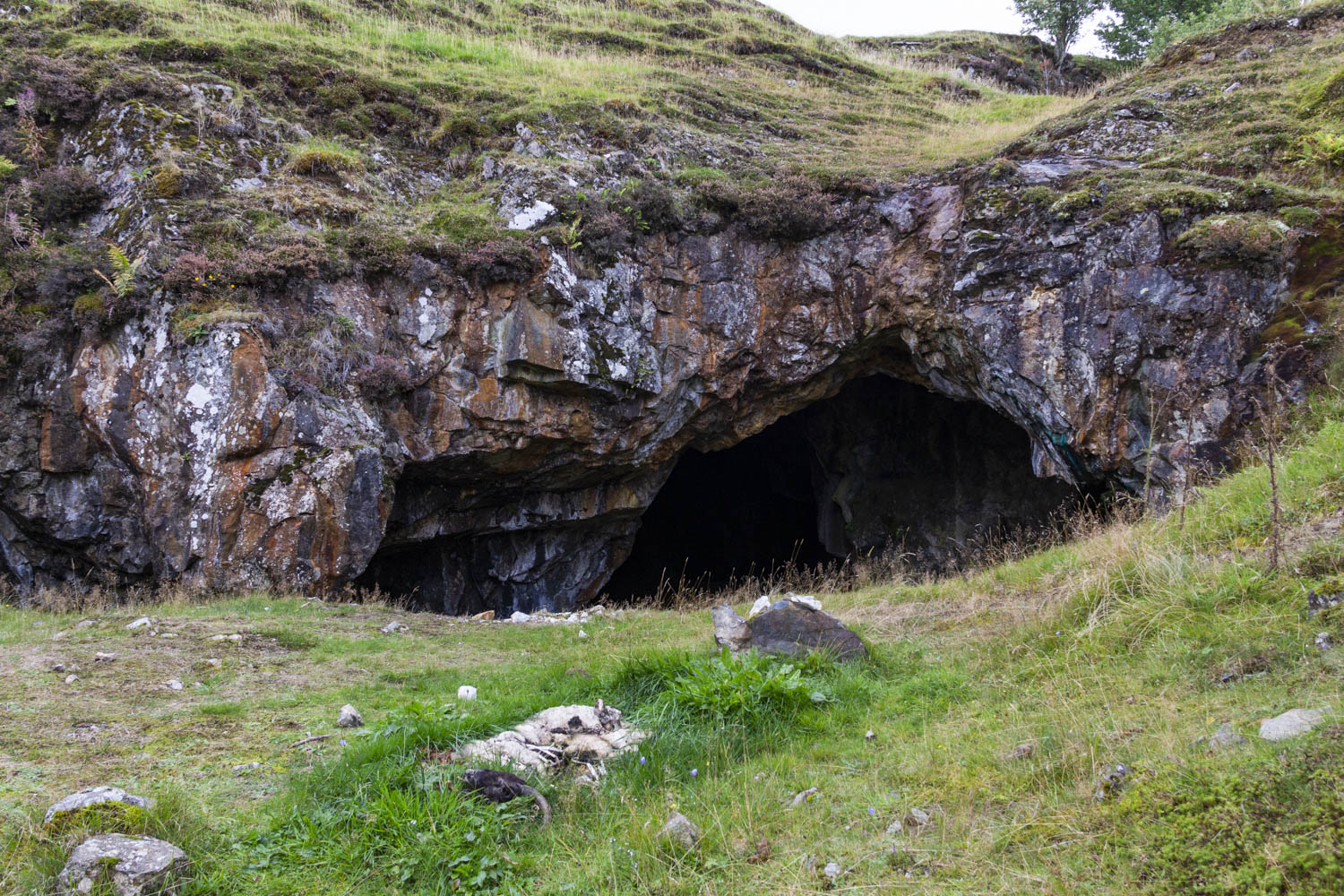
Tomnadashan mine of Monty Python fame, with dead sheep (Photo: Paul Stafford for TravelMag.com)
Tomnadashan is a disused copper. Its entranceway passed into popular culture for a very different reason than Rob Roy, for it was used as the Cave of Caerbannog in Monty Python and the Holy Grail. Those who have seen the film may recall the killer rabbit, the Black Beast of Arrrghhh, that flies through the air kills people with its “pointy teeth.”
Using an ever-trusty OS Map to locate the probable site, simply labelled ‘mine,’ I clambered a fence into a field, only to realise it held a herd of cattle. A rush of adrenaline hit me upon realising that I was acting no different than one of the mad herdsmen. I tried to ignore the curious cows (they would have been very easy to herd up) and scrambled up the grassy slope, looking for the mine’s entrance. Hidden in a dip, it seemed completely unchanged from the film. As though the Black Beast of Arrrghhh were real, a rotting carcass of an unfortunate sheep lay outside the entrance.
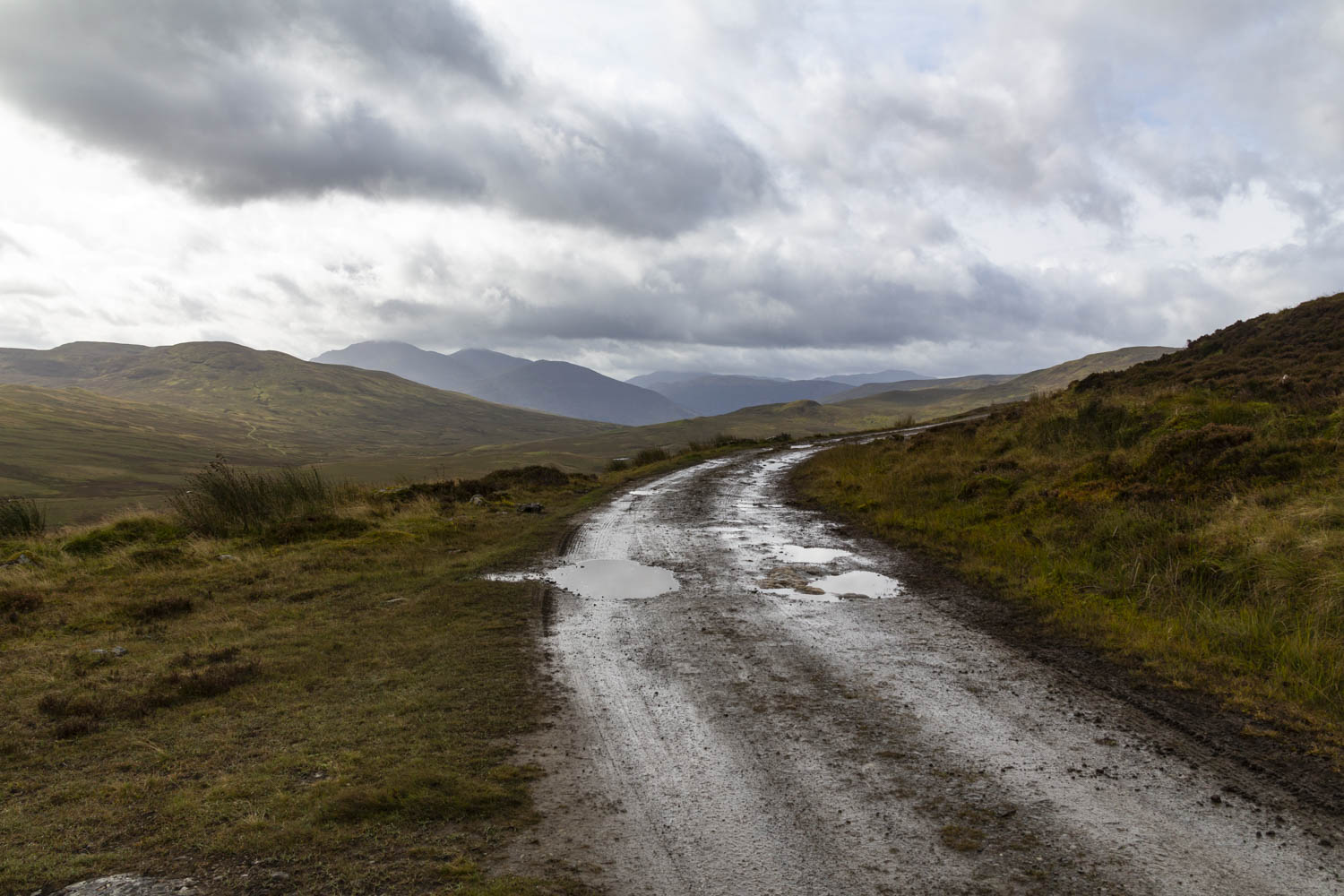
Around Meall Odhar (Photo: Paul Stafford for TravelMag.com)
Fugitive Hideaways
Suitably film-geeked out, I heaved myself back over the fence and followed the path up onto the moors as it deviated from the loch. The land was open and desolate. Only occasional wooden posts marked the way, as the path disappeared in a marshy mire. A blanket of rain filled the air as I trudged onwards, hoping my boots would stay dry on the inside. The hardship of walking was enough to dissuade anybody from stealing livestock in these parts. It seemed like the ideal natural defence.
This was a desolation in which one could hide unseen. The crags of Meall Odhar could have hidden a small army. They were parsed by a weaving path that dropped down past a reservoir then into the disorientating abyss of a managed forest until reaching the passage south, away from Loch Tay for good. The auburn hillsides of Glen Ogle funnelled a track towards Loch Earn. The remnants of another former railway added pretty manmade features to the natural display, such as a curving viaduct which swung the path towards Strathyre.
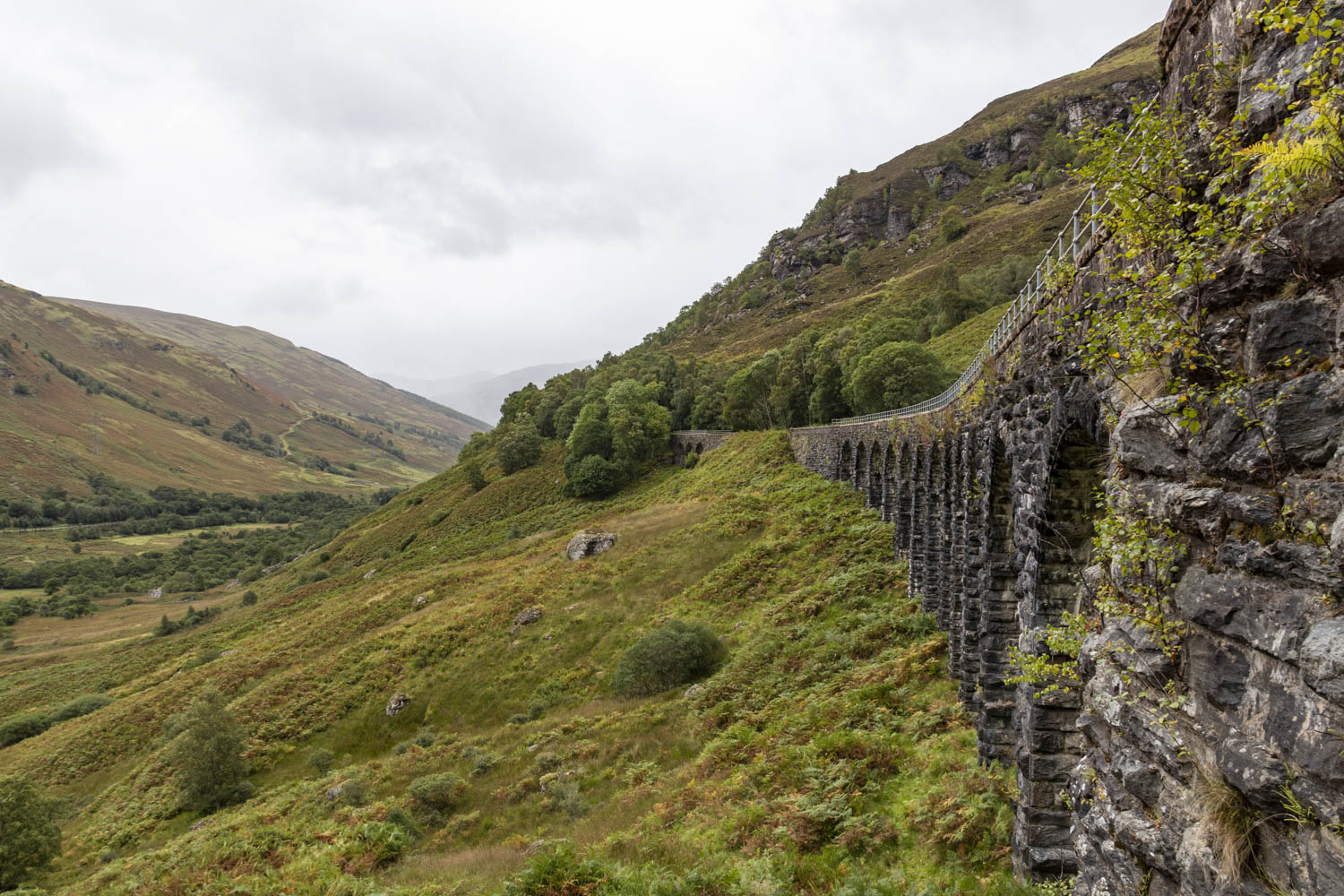
Glen Ogle Viaduct (Photo: Paul Stafford for TravelMag.com)
A Glimpse of Rob Roy?
Although there was still no sense of direct connection to the famed outlaw, this was territory he would have known well. By 1712 Rob Roy MacGregor was involved in the trading and droving of cattle for Clan Chiefs and landed gentry, having gained prominence through his less judicious business. This became his undoing when the Marquis of Montrose trusted Rob Roy with £1,000 to increase his head of cattle. The money went missing, supposedly stolen by an ally of MacGregor’s.
Being unable (or unwilling) to repay the debt, Rob Roy was made an outlaw and remained on the run, mostly finding shelter along Glen Ogle, while also fighting a battle during ‘the Fifteen,’ as the ill-fated Jacobite uprising of 1715 is known. The Highland Clans had mostly sided with the Jacobite cause. This choice would ultimately lead to the proscription of Highland customs, culture and dress and worse yet, the Clearances, which historian Norman Davies notes “gave the Highlands that haunting emptiness which unknowing tourists have admired ever since.”
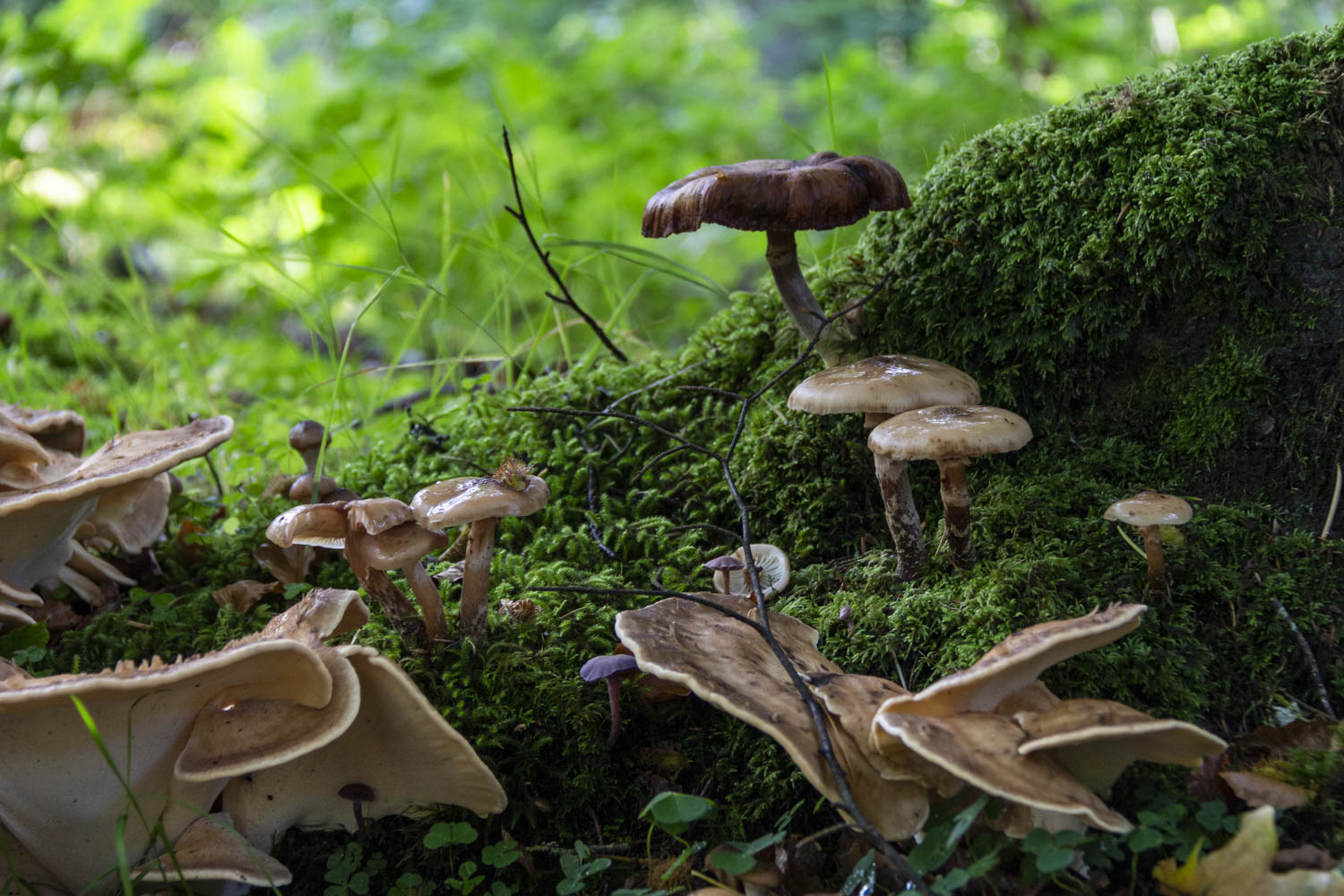
Mushrooms growing near Balquhidder (Photo: Paul Stafford for TravelMag.com)
Near Strathyre the path split, one to the inn where I had a bed booked, the other to Balquhidder, which lay a few miles from the route. This was the place with the strongest connection to Rob Roy, for it is where he is said to be buried. My body suggested that Balquhidder, and Rob Roy, could wait until the morning. At the inn, I fell into bed, exhausted. My last thoughts of the day were tinged with dread at having to cover a similar distance the next day, and a sense of guilt, knowing it would have been much harder for one to pass this way as an outlaw, so I technically had it easy.
A Sacred Grave
The sound of early morning bird song echoed through the woods as I wandered the backcountry road to Balquhidder from Strathyre. It was easy to see what made the area alluring to outlaws and lovers of Scotland in equal measure. There was a delicate beauty to the country. It was also munificent: Giant mushrooms grew on practically every tree trunk. The sound of running water was often to be heard, although seldom seen.
Upon reaching the glen containing Balquhidder, beside Loch Voil, I could see how secluded the area was, closed in by mountains to the north and east, rivers to the west and mountainous wilderness to the south. Passes cut through the southern ridge to isolated land around Loch Katrine that would have provided a means of escape. To this day, Balquhidder is in one of region’s prettiest, naturally sheltered little valleys.
Rob Roy wanted little more in his later years than to settle around Balquhidder. But in 1717 he was taken by surprise and captured there by the Marquis of Montrose. He managed to escape while his captors were fording the River Forth, an escape act that buoyed his legend.
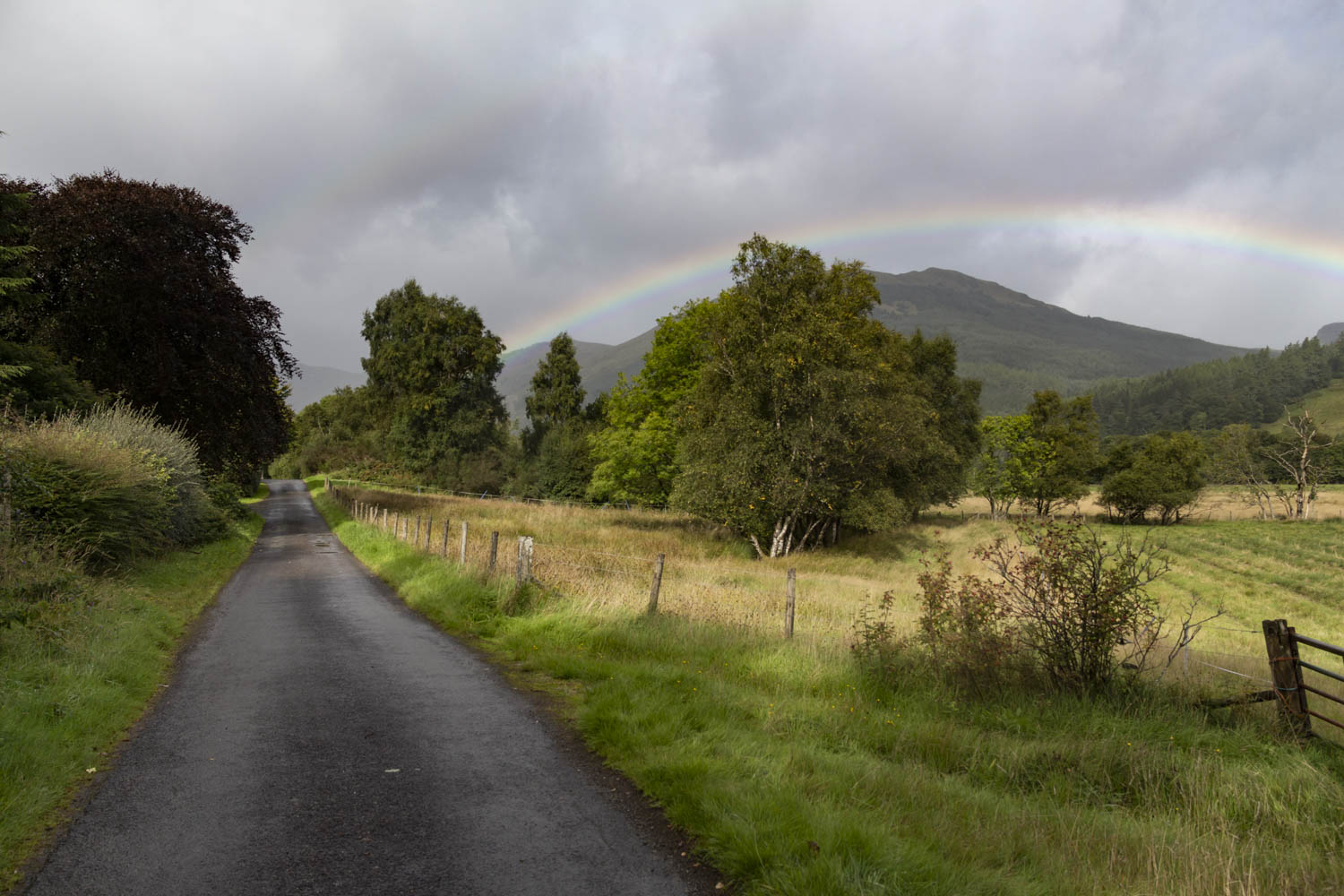
A rainbow directly over Rob Roy’s buried place (Photo: Paul Stafford for TravelMag.com)
Just outside Balquhidder the rain and the sun jostled for sky, and a rainbow stretched right across the village, and Rob Roy’s burial site. By the time I reached the parish church it was sunny again. I soon found a collection of three gravestones for Robert MacGregor, with the year of death listed as 1734 (meaning he lived to the ripe old age of 63), Helen, his widow and two of his sons.
Back at Strathyre I continued south past the undulating alpine shores of Loch Lubnaig to Callander, then through rolling country, knowing in my heart (and feet, mostly) that this was to be my final stretch of the trail.
Aberfoyle is the main place of note on the Rob Roy Way relating to Sir Walter Scott’s novel, for it is where a good deal of the book’s action within the Highlands takes place. I arrived just after dark, remembering the now-dated description of the reception young Osbaldistone, the narrator, received: “a staring half-clad wench or two came out of the inn and neighbouring cottages on hearing the sound of our horses’ feet. No one bade us welcome, nor did any offer to take our horses.”
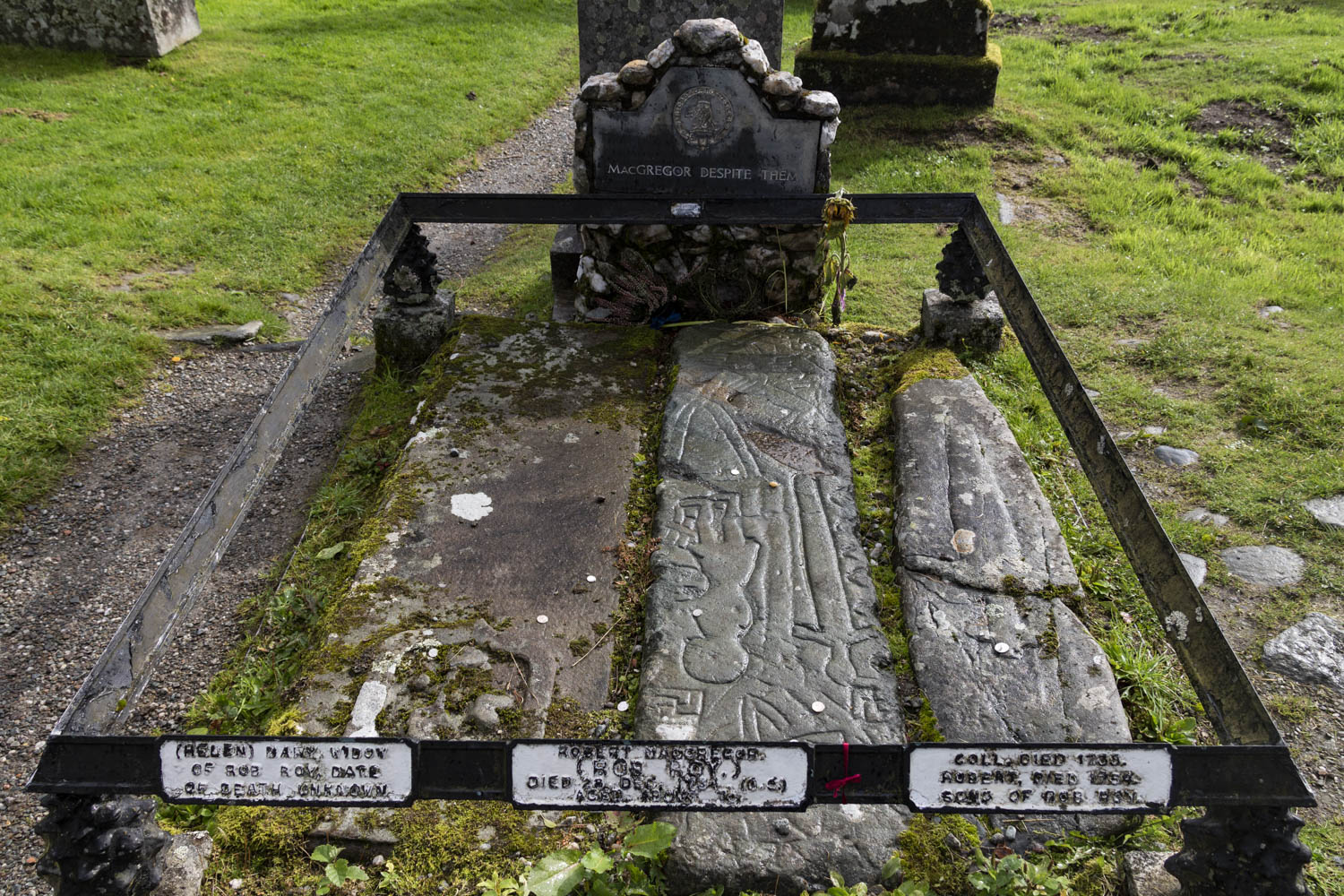
Graves of Rob Roy MacGregor, his wife and sons (Photo: Paul Stafford for TravelMag.com)
The streets of Aberfoyle were empty. The River Forth, which “bridles the wild Highlandman,” slinked silently through the trees to the south of the town centre. I was 11 miles from my Drymen terminus. I decided I was done. I’d walked my fill and would walk no more. Neither would Rob Roy, I thought. That’s what people would have expected him to do. A platitude to my ego, more than anything else. But I had finally felt some connection to Rob Roy. And on reflection, the fact that Rob Roy remained largely elusive is perhaps the point. A successful outlaw is not readily found, even on his own path.
This is perhaps what best explains the manner in which Rob Roy’s legend endures today in popular culture, because enough blanks were left for the imagination to fill. The Rob Roy Way itself explores an intriguing cross-section of Scotland through the Lowlands-Highlands divide; one that has barely changed in the last three centuries. It is both wild and refined, and every inch the territory of a gentleman outlaw.
For more information about accommodation, guides and maps, visit www.robroyway.com